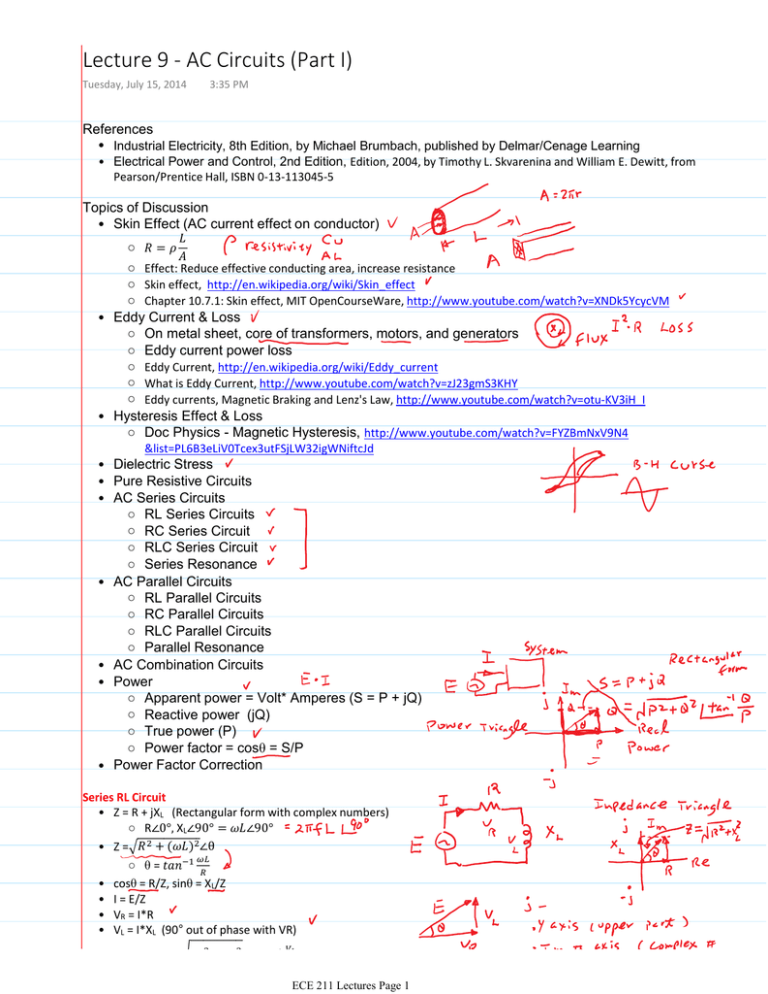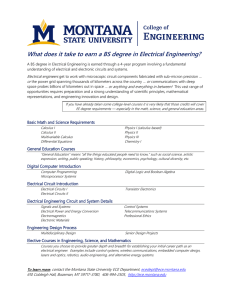
Lecture 9 - AC Circuits (Part I)
Tuesday, July 15, 2014
3:35 PM
References
• Industrial Electricity, 8th Edition, by Michael Brumbach, published by Delmar/Cenage Learning
• Electrical Power and Control, 2nd Edition, Edition, 2004, by Timothy L. Skvarenina and William E. Dewitt, from
Pearson/Prentice Hall, ISBN 0-13-113045-5
Topics of Discussion
• Skin Effect (AC current effect on conductor)
○
○ Effect: Reduce effective conducting area, increase resistance
○ Skin effect, http://en.wikipedia.org/wiki/Skin_effect
○ Chapter 10.7.1: Skin effect, MIT OpenCourseWare, http://www.youtube.com/watch?v=XNDk5YcycVM
• Eddy Current & Loss
○ On metal sheet, core of transformers, motors, and generators
○ Eddy current power loss
○ Eddy Current, http://en.wikipedia.org/wiki/Eddy_current
○ What is Eddy Current, http://www.youtube.com/watch?v=zJ23gmS3KHY
○ Eddy currents, Magnetic Braking and Lenz's Law, http://www.youtube.com/watch?v=otu-KV3iH_I
• Hysteresis Effect & Loss
○ Doc Physics - Magnetic Hysteresis, http://www.youtube.com/watch?v=FYZBmNxV9N4
&list=PL6B3eLiV0Tcex3utFSjLW32igWNiftcJd
• Dielectric Stress
• Pure Resistive Circuits
• AC Series Circuits
○ RL Series Circuits
○ RC Series Circuit
○ RLC Series Circuit
○ Series Resonance
• AC Parallel Circuits
○ RL Parallel Circuits
○ RC Parallel Circuits
○ RLC Parallel Circuits
○ Parallel Resonance
• AC Combination Circuits
• Power
○ Apparent power = Volt* Amperes (S = P + jQ)
○ Reactive power (jQ)
○ True power (P)
○ Power factor = cosθ = S/P
• Power Factor Correction
Series RL Circuit
• Z = R + jXL (Rectangular form with complex numbers)
XL
○ R
• Z=
○ θ=
• cosθ = R/Z, sinθ = XL/Z
• I = E/Z
• VR = I*R
• VL = I*XL (90° out of phase with VR)
• E = VR + jVL =
ECE 211 Lectures Page 1
• I = E/Z
• VR = I*R
• VL = I*XL (90° out of phase with VR)
• E = VR + jVL =
Example 1: Given a coil with R = 10Ω, L = 0.04 henry; power source E = 120 V, 60Hz, find
(a) Z ? (18 Ω)
Z = R + jXL = R + jωL = R + j(2*π*f*L)
(b) I, VR, VL
(c) Power dissipated and Power Factor
Example 2: RL series circuit with R = 10Ω, L = 0.05 H
If the supply voltage from a 60-Hz source and I = 10A, find voltage across each component.
(a) Need to find XL = ωL
Example 3: Use the RL circuit in example 2 and find
(a) the impedance (21.3 ohms)
ECE 211 Lectures Page 2
(b) the true power (1 kW)
(c) the apparent power (S = 2.13 kVA)
(d) the reactive power (Q = 1.881 kVAR)
(e) the power factor (cosθ = P/S = 0.46)
Series RC Circuits
• Z = R - jXC (Rectangular form with complex numbers)
Xc
○ R
• Z=
•
•
•
•
○ θ=
cosθ = R/Z, sinθ = Xc/Z
I = E/Z
VR = I*R
Vc = I*Xc (90° out of phase with VR)
• E = VR - jVc =
Example 4:
If R = 5Ω, and C = 900 μF are in series; power supply 120-V, 60Hz, find
(a) Z
(b) I
(c ) VR, VC
(d) power dissipated
ECE 211 Lectures Page 3
(d) power dissipated
(e) power factor
Series RLC Circuits
• Z = R + j(XL - XC)
• Z=
Example 5:
R = 5Ω, C = 900μF, L = 0.02H, power source 120-V 60Hz, find
(a) Z
(b) I
(c ) VL, VC
(d) Power dissipated and Power factor
Example 6:
For a RLC series circuits, given VR =88.5V, VL = 133.5V, VC = 52.2V, find power source voltage.
ECE 211 Lectures Page 4
For a RLC series circuits, given VR =88.5V, VL = 133.5V, VC = 52.2V, find power source voltage.
Example 7:
For a RL series circuit, with R = 5Ω, XL = 7.54Ω, find power factor of the circuit.
Series Resonance:
For a RLC circuit with Z = R + j(X L - XC), when XL = XC or 2πfL = 1/(2πfC) occurs:
(a) the circuit has the minimum resistance
(b) current and voltage are in phase
(c ) PF = 1, max power occur
Example 8: A RLC series circuit with R = 5Ω, L = 0.02H, and power source 120-V 60Hz, what is the C needed to bring the
power factor to 100%?
Z = R + j(XL - XC)
XL = XC or 2πfL = 1/(2πfC)
Example 10:
What is resonance frequency of the RLC series circuit with R = 5Ω, L = 0.02H, C = 200 μF?
ECE 211 Lectures Page 5
Example 10:
What is resonance frequency of the RLC series circuit with R = 5Ω, L = 0.02H, C = 200 μF?
ECE 211 Lectures Page 6




